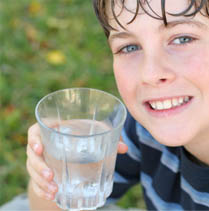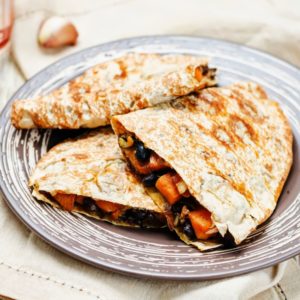
During summer when your kids head off to day camp, don’t let them leave the house without their most important accessory – water! Keep these tips in mind.
Staying hydrated, also known as maintaining proper water balance within the body, is an important concern for parents and their active children during the hot summer months.
The Sensation of Thirst Does Ensure Adequate Hydration.
Research shows that beverage intake at meals is adequate for keeping your body hydrated, or water-balanced unless there is an increase in physical activity.
- A study showed that about 20% to 25% of total fluid intake comes from food.
- Most fluid from food comes from fruit and vegetables, one more reason to eat 5-9 servings of fruit and vegetables a day!
Water Requirements Change Based on Age.
Though most Americans believe 8 cups of water will maintain hydration status, this answer is only correct for males 9-13 years of age (see table below). Water needs change with gender and age and they vary due to factors like environment, metabolism and physical activity level. The table below shows the Adequate Intake (AI), or the median intakes of total water reported by a national survey for proper hydration status.
Proper Hydration During the Life Cycle: Total Daily Adequate Intake (AI)
| Age | Daily Amount in Liters (1 Liter = ~ 4 cups) |
| Infants (0-6 months) | 0.7 L (3 cups) |
| Infants (7-12 months) | 0.8 L (3.5 cups) |
| Children (1-3 years of age) | 1.3 L (5.5 cups) |
| Children (4-8 years of age) | 1.4 L (6 cups) |
| Males | |
| 9-13 years of age | 2.4 L (10 cups) |
| 14-18 years of age | 3.3 L (13 cups) |
| Older than 19 years of age | 3.7 L (15 cups) |
| Females | |
| 9-13 years of age | 2.1 L (8.5 cups) |
| 14-18 years of age | 2.3 L (9 cups) |
| Older than 19 years of age | 2.7 L (11 cups) |
Active Children Need More Water than Active Adults.
Though the above graph shows an increase in water needs as people age, total water intake is 4 times greater in infants than in adults. There are currently no perfect water intake guidelines for infants and children. The rate of growth and water composition also differ for exclusively breastfed and formula-fed infants, making it hard to define.
Replacing Sugar-Sweetened Beverages with Water is a Good Idea.
When sugar-sweetened beverages are replaced with water, this will result in a decrease in overall caloric intake with no negative benefit on health. Your kids are running around all day in the sun, so what do your offer them to drink? We are here to tell you that water does just as good a job of hydration as sugar-sweetened beverages like Gatorade and PowerAde for exercise less than about an hour and a half, and when paired with the right foods to fuel their fitness. In fact, switching out the sugary beverages for water can lower children’s intake of empty calories by an average of 235 calories and lower their risk for childhood obesity. Empty calories are calories from food with no nutritional value and most of the time end up in body fat production. Say yes to good old-fashioned water and no to childhood obesity. Be aware of how companies market junk beverages to your children and know how to stop it!
Ways to decrease consumption of sweetened beverages.
There are many ways to decrease the number of sweetened beverages your child (and you!) consume and promote healthy hydration and health. Here are a few ideas to get you started:
- Mix half fruit juice with half water or seltzer water for a lighter fruity treat.
- Invest in a water filter and keep cool water stored in the fridge for thirsty eyes to see.
- Slowly decrease the number of sweetened beverages that you bring into your home. Gradual change may go over better than stopping cold turkey.
- Encourage water intake by making it easy and fun! Send your children to school with BPA-free water bottles to drink during lunch and during the school day. (There will be a label on the water bottle noting that it is BPA-free).
- Try watered down juice boxes – one of the easiest ways to encourage water intake among children. Check to see if they are available in your grocery store.
- Change up the way you drink water by adding fun flavors such as:
- Fresh Cut Cucumbers
- Fragrant Orange Slices
- Refreshing Mint and Lime Juice
- Squeeze of Lemon Juice
For more on sweetened beverages, read Health Problems Associated with Sweetened Beverages
Staying Hydrated Helps Increase Physical Performance.
Hydration plays a role in physical performance. Dehydration can result in decreased performance of high-intensity and long sustaining activities by reducing muscle strength. Studies show that even small decreases in exercise performance can significantly alter the outcome of an athletic event – remember this at the soccer game half time!
Over-Hydration is Rare But Just as Bad as Dehydration.
Before you go tell your child to drink up, don’t go overboard. Humans have a built-in system that stops our ability to store water. When a person drinks too much fluid, hormones tell your body to make urine to control fluid balance. If a person drinks too much over a short period of time before this system can take place, it is possible to develop a serious medical illness known as water intoxication or hyponatremia (low blood-salt level). Water intoxication, when your body does not work because it is overloaded with water, is very rare but can be fatal.












